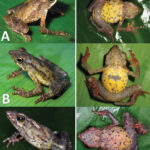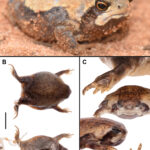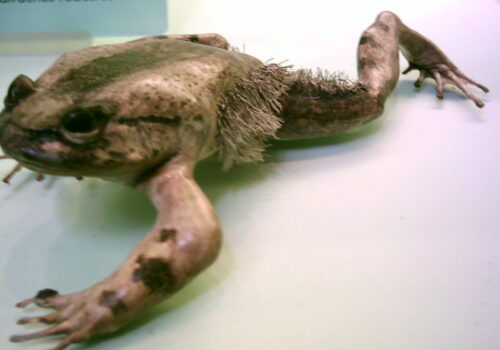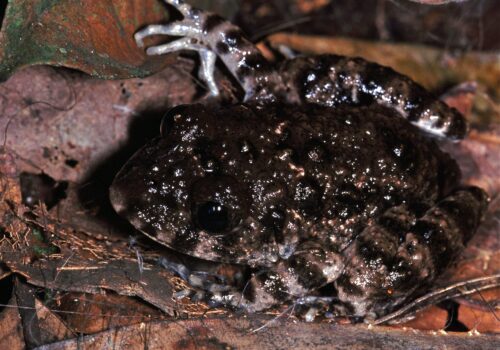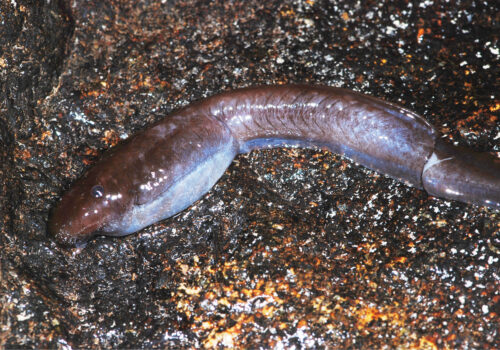- Introduction: A Dancer Among Forest Streams
- Taxonomy and Classification: Placing Mannophryne oblitterata Within Nature's Tree of Life
- Natural Habitat: Venezuela's Verdant Woodland Streams
- Physical Characteristics: Beauty in Compact Form
- Behavior and Life Cycle: An Uncommon Tenderness
- Ecological Role: Vital Links Within the Web
- Threats and Conservation Status: Standing Against Silent Declines
- Cultural and Scientific Significance: Beyond Ecological Boundaries
- Conclusion: Protecting Venezuela’s Rainforest Guardians
Introduction: A Dancer Among Forest Streams#
Hidden among leaf-littered forest floors and crystal-clear streams in northern Venezuela, a small, strikingly patterned frog moves swiftly and silently—yet plays an outsized role in the delicate tapestry of its rainforest home. Mannophryne oblitterata, a member of the Aromobatidae family, is not well-known outside scientific circles, yet it captures attention with its vivid appearance and intriguing lifestyle. Its elegant alternating patterns and energetic bursts through shadowy streams catch fleeting glimpses from curious observers. Although modest in size, this amphibian offers invaluable insights into rainforest health and the interconnectedness of ecosystems.
One curious fact about M. oblitterata is its sophisticated parental behaviors. Unlike many amphibians, this species demonstrates remarkable care for its offspring, a rare and captivating behavior among forest frogs. But beyond its remarkable appearance and engaging reproductive life, this elusive creature stands as a sentinel of biodiversity and environmental health, signaling subtle changes in its forest home.
Taxonomy and Classification: Placing Mannophryne oblitterata Within Nature’s Tree of Life#
The complex scientific journey toward identifying and understanding Mannophryne oblitterata began with its formal description in 1984 by researchers Rivero and Serna. Taxonomically, this species is classified within the family Aromobatidae, a group known for their intricate behaviors and dynamic terrestrial lifestyles. Within its genus, Mannophryne, this species shares lineage with other brightly patterned, stream-dwelling frogs inhabiting the cloud forests and tropical rainforests of northern South America.
Closely related species within the Mannophryne genus include Mannophryne trinitatis and Mannophryne herminae, known collectively for their distinctive mating rituals and vibrant colors. Scientists study these frogs not only for their aesthetic beauty but also for the shared ecological traits and evolutionary connections they reveal about adaptability to unique rainforest environments.
Natural Habitat: Venezuela’s Verdant Woodland Streams#
Mannophryne oblitterata thrives within a specialized niche: shaded streams, humid gullies, and the moist leaf-littered forests found in northern Venezuela, particularly within the Cordillera de la Costa mountain range. Here, the dense vegetation and sheltered canopy create microclimates ideal for amphibians requiring consistently humid conditions and clean freshwater bodies.
These ecosystems, vibrant and sprawling, provide habitat not only for M. oblitterata but countless other amphibians, reptiles, insects, and unique plant species. The frog’s preferred habitat typically consists of pristine streams lined with rocks, fallen logs, mosses, and leaf litter, allowing it ample shelter from predators and easy access to its primary food sources. Its life is intricately tied to this environment—any changes to stream chemistry or forest structure ripple quickly through this delicate ecosystem, impacting its survival directly.
Physical Characteristics: Beauty in Compact Form#
Despite its diminutive size, seldom exceeding 25 millimeters, Mannophryne oblitterata makes a striking visual statement in its rainforest habitat. Its colors range from chocolatey browns and rustic earthy tones to vibrant yellows and contrasting lighter stripes—hence the common name “harlequin frogs” often used within its genus. This mottled yet beautifully consistent pattern offers ideal camouflage amidst fallen leaves, sunlight-dappled forest floors, and rocky streambeds.
The frog’s lithe, agile limbs enable rapid movement, short leaps, and smooth motions across slippery rocks near water bodies where slippery surfaces and swift predators demand precise, effective locomotion. Large, expressive eyes positioned toward the top of its head provide an expansive field of vision—essential for spotting danger or prey in a highly competitive ecosystem. Even their subtle adaptations, such as textured skin and muscular legs, illustrate a creature superbly evolved to thrive within its challenging habitat.
Behavior and Life Cycle: An Uncommon Tenderness#
Feeding Habits: Swift Predators of Forest Floors#
Mannophryne oblitterata actively hunts small crawling arthropods and insect larvae, often targeting ants, mites, termites, and small beetles. Equipped with exceptional eyesight and lightning reflexes, it navigates through complex microhabitats, swiftly snapping up prey while carefully avoiding becoming a meal itself to snakes, birds, and larger predatory amphibians.
Breeding Behavior and Offspring Care#
The mating and reproductive cycle of M. oblitterata showcases one of nature’s more endearing parental strategies. Male frogs diligently court females through a sequence of soft yet persistent calls, gentle movements, and subtle visual displays along the edges of streams. Upon the female laying her eggs, usually tucked safely under rocks or logs, a remarkable responsibility then falls notably upon the male. Unlike most frog species, males exhibit dedicated paternal care, fiercely guarding egg masses from predators and environmental stresses.
After hatching, the tiny tadpoles are carried meticulously upon the male’s back, one by one, to safe nursery pools and secondary water bodies. This remarkable ecological behavior ensures greater chances of survival, significantly increasing the odds for offspring to reach maturity despite threats in their natural environment. Witnessing these frogs gently carrying their young emphasizes the complexity and emotional resonance hidden within amphibian life.
Ecological Role: Vital Links Within the Web#
As both predator and prey, Mannophryne oblitterata maintains a critical balancing role within its environment. It controls insect populations while simultaneously providing nourishment to larger predators including snakes, birds, and other amphibians. Due to its selective habitat preferences, the species also serves as a highly sensitive indicator of ecological health. Small changes in water quality, temperature variations, pollution, or disease impacts are immediately reflected in their populations, making them a barometer of wider environmental changes and ecosystem degradation.
Threats and Conservation Status: Standing Against Silent Declines#
Unfortunately, like many rainforest frogs, M. oblitterata confronts multiple threats including habitat destruction, water pollution, climate change, and disease—most notably the devastating fungal disease known as chytridiomycosis. Human activities such as mining, agricultural expansion, and deforestation have fragmented and significantly reduced prime habitats, while rising global temperatures alter rainfall patterns, impacting breeding cycles and water availability.
The International Union for Conservation of Nature (IUCN) currently lists Mannophryne oblitterata as “Data Deficient,” reflecting limited distributional data and ongoing habitat assessments. Conservation scientists emphasize local habitat protections, ecological research, and raising awareness for the species to prevent potential unnoticed declines before it becomes severely at risk.
Cultural and Scientific Significance: Beyond Ecological Boundaries#
In Venezuelan folklore and traditional forest communities, frogs often symbolize environmental prosperity, fertility, or imminent climatic changes. Although direct cultural narratives specifically regarding M. oblitterata may not be extensively documented, rainforest frogs collectively symbolize intertwined human and natural worlds, reflecting wisdom about respecting the limits and richness of biodiversity in indigenous cultural traditions.
From a scientific perspective, this frog and its kin have intriguing biochemical and ecological potentials. Investigations into skin secretions could uncover novel antimicrobial compounds or medicinal possibilities, while behavioral studies continue to inform broader ecological and environmental education fields.
Conclusion: Protecting Venezuela’s Rainforest Guardians#
Mannophryne oblitterata, though small and inconspicuous to the untrained eye, embodies remarkable ecological complexity, intriguing behaviors, and resilient adaptability in its lush Venezuelan homeland. Understanding this hidden harlequin of forest streams enriches our appreciation for nature’s subtle complexity and reminds us of our own ecological responsibilities.
By further exploring and actively supporting conservation initiatives, whether through habitat protection, environmental education, or advocating policy changes, each one of us can help ensure this dazzling little amphibian continues to leap, swim, and thrive quietly beneath rainforest canopies for generations to come.


